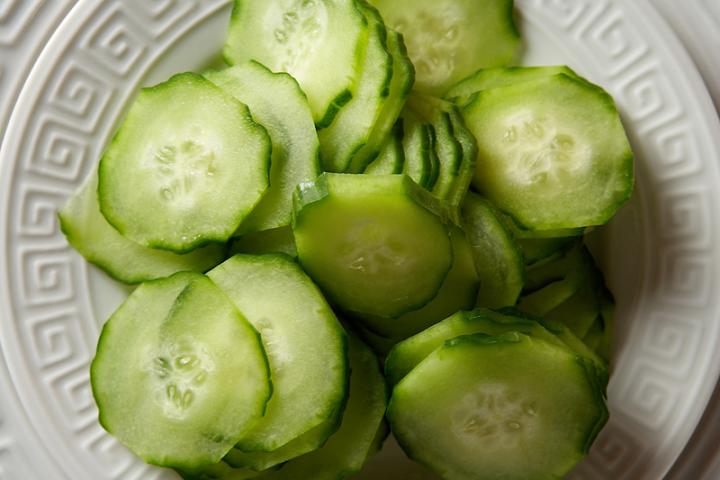
Cucumbers are a warm-season vegetable planted outside in the ground no earlier than 2 weeks after last spring frost date.
Most varieties will grow in any amount of space, thanks to the plant’s ability to climb. The most common varieties of slicing cucumbers grow on vigorous vines shaded by large leaves. The growth of these plants is fast, and the crop yield is abundant if you care for them properly.
Planting
- Cucumbers are seeded or transplanted outside in the ground no earlier than 2 weeks after last frost date. Cucumbers are extremely susceptible to frost damage; the soil must be at least 65ºF for germination. Do not plant outside too soon!
- For an early crop, start cucumber seeds indoors about 3 weeks before you transplant them in the ground. They like bottom heat of about 70ºF (21ºC). If you don’t have a heat mat, put the seeds flat on top of the refrigerator or perch a few on top of the water heater.
- Before you plant outside, select a site with full sun.
- Ideally, soil should be neutral or slightly alkaline with a pH of 7.0. Improve clay soil by adding organic matter. Improve dense, heavy soili by adding peat, compost or rotted manure. (Get a soil test if you are unsure of your soil type; contact your local county cooperative extension.) Light, sandy soils are preferred for northern gardens, as they warm quickly in the spring.
- Mix in compost and/or aged manure before planting to a depth of 2 inches and work into the soil 6 to 8 inches deep. Make sure that soil is moist and well-drained, not soggy.
- Sow seeds in rows, 1 inch deep and 6 to 10 inches apart.
- If you are transplanting seedlings, plant them 12 inches apart.
- A trellis might be a good idea if you want the vine to climb, or if you have limited space. Trellising also protects the fruit from damage from lying on the moist ground.
Care
- When planting seeds in the ground, cover with netting or a berry basket to keep pests from digging out the seeds.
- When seedlings emerge, begin to water frequently, and increase to a gallon per week after fruit forms.
- When seedlings reach 4 inches tall, thin plants so that they are 1½ feet apart.
- If you’ve worked in organic matter into the soil before planting, you may only need to side-dress your plants with compost or well-rotted manure. Or, if you wish, use a fertilizer from your garden store which is low nitrogen/high poatassium and phosphorus formula and apply at planting, 1 week after bloom, and every 3 weeks with liquid food, applying directly to the soil around the plants. Or, you can work a granular fertilizer into the soil. Do not overfertilize or the fruits will get stunted.
- Water consistently; put your finger in the soil and when it is dry past the first joint of your finger, it is time to water. Inconsistent watering leads to bitter-tasting fruit. Water slowly in the morning or early afternoon, avoding the leaves.
- Mulch to hold in soil moisture.
- If you have limited space or would prefer vertical vines, set up trellises early to avoid damage to seedlings and vines.
- Spray vines with sugar water to attract bees and set more fruit.
Pests/Diseases
- Cucumbers may not set fruit because the first flowers were all male. Both female and male flowers must be blooming at the same time. This may not happen early in the plant’s life, so be patient.
- Lack of fruit may also be due to poor pollination by bees, especially if prevented by rain, cold temperatures, or insecticides. Remember, gynoecious hybrids require pollinator plants.
- Cucumber Beetles
- Whiteflies
- Bacterial Wilt
- Anthracnose
- Mosaic Viruses
Harvest/Storage
- Harvest regular slicing cucumbers when they about 6 to 8 inches long (slicing varieties).
- Harvest dills at 4 to 6 inches long and pickles at 2 inches long for pickles. The large burpless cucumbers can be up to 10 inches long and some types are even larger.
- Cucumbers are best picked before they seeds become hard and are eaten when immature. Do not let them get yellow. A cucumber is of highest quality when it is uniformly green, firm and crisp.
- Any cucumbers left on the vine too long will also get tough skins and lower plant productivity.
- At peak harvesting time, you should be picking cucumbers every couple of days.
- Keep them picked. If you don’t, as plants mature, they will stop producing.
- Cucumbers are over 90 percent water. Store wrapped tightly in plastic wrap to retain moisture.
- They will keep for a week to 10 days when stored properly in the refrigerator.
Recommended Varieties
- ‘Sweet Success’
- ‘Straight Eight’
- ‘County Fair’
Wit & Wisdom
- Plant cucumbers while you are wearing your pajamas, on the first day of May, before sunrise, and no bugs will eat them.
- Make a second planting. In already-warm summer soil, cucumbers will grow quickly and ripen ina bout six weeks!
- Don’t forget that cucumbers aren’t just for eating. When puréed in the blender, cucumbers make a great summer facial for toning the skin. Check out other great and unexpected uses for cucumbers.
- With special molds, you can grow cucumbers in different shapes like hearts and stars!
Recipes
- Cucumbers with Feta Cheese Dressing
- Chilled Cucumber Soup
- Castilian-Style Cucumber and Tomato Salad
Cooking Notes
See our fun video on How to Make Easy Refrigerator Dill Pickles!






